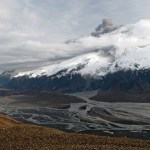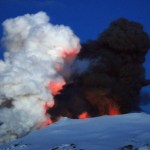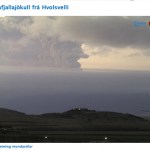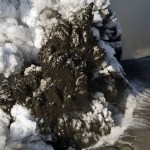volcanoes in the media
Dark ash covers an American Airline 737 on the tarmac at the airport in Guatemala City.
Two volcanoes are making headlines right now (and neither is in Iceland).
As I mentioned yesterday, Pacaya in Guatemala erupted (video) causing widespread disruption of life in the nearby Guatemala City and costing two people their lives (including a TV reporter who got too close to the vent). Almost 2,000 people have been evacuated from the region near the volcano. The BBC has posted some impressive video of the eruption of Pacaya, showing the strombolian explosions sending basaltic tephra high into the…
This week has been destroyed by workshops and my last death throes with a paper I am submitting on my research in New Zealand. And to think, I thought it might settle down a little after the students left.
To news!
Ash fall on a taxi cab near Guatemala's Pacaya.
Pacaya in Guatemala erupted yesterday causing evacuations of people near the volcano and the closure of Guatemala City's main airport. Pacaya is a mere ~25 km from the capitol of this Central American nation. Tragically, a news reporter from one of the capitol's TV stations died when they were struck by volcanic debris, again…
Brief news!
Lava flows reaching the sea at Kilauea in Hawai`i. Image from November 2009, courtesy of HVO/USGS.
The Alert Status at Cleveland in the Alaskan Aleutian Islands was raised to Yellow (Advisory) by the Alaska Volcano Observatory after new signs of activity emerged. The latest report from AVO on the volcano says a thermal anomaly has been spotted at the summit, which typically is one of the first signs that the volcano is entering an eruption period. However, there is no real-time seismic monitoring for Cleveland, so that is the only clue (right now) that AVO has. Cleveland is a…
Nyiragongo in the Democratic Republic of the Congo.
Following up on a report earlier this week claiming that an eruption of Mikeno produced an avalanche that killed dozens, it appears that those reports were false. Current news claims that an overflowing river on Nyiragongo in the Congo produced an avalanche on the slopes of the volcano. This avalanche killed 46 people and have wiped out at least 200 homes and UN Peacekeepers in the Congo have been helping with the recovery from the avalanche. So, it seems that the landslide was caused by heavy rains rather than any sort of volcanic eruption…
News, news, news!
Ash from Eyjafjallajökull piling up on a roof at Seljavellir. Image courtesy of the IMO, by Ari Tryggvason.
The latest from Eyjafjallajökull has the volcano continuing to puff away - producing intermittent airspace closures over Europe. The Icelandic Met Office reports a ~7 km (21,000 foot) ash plume, but they note that the explosivity of the eruption seems to have waned some since a maximum on May 13. Right now, the IMO estimates the eruption rate at ~200 tonnes/second. Lets put that in a little perspective - a Ford F-150 pickup weighs about 2 tonnes, so the volcano is…
Part 2 of your recollections of the May 18, 1980 eruption of Mount St. Helens.
You can read Part 1 here.
You can also check out an amazing set of satellite images spanning 1979-2010 at the NASA Earth Observatory. Great stuff!
-------------------------------------------------------------------------------------------------
Eruption plume from Mount St. Helens on May 18, 1980. Image courtesy of the USGS/CVO.
Peter Carlton
My sister and I were playing in our backyard in West Seattle when we heard the boom. I was 6 years old. I remember lots of phone calls with our relatives in Yakima, watching…
May 18, 2010 marks the 30th anniversary of the dramatic eruption of Mount St. Helens in Washington state. Now, rather than recount the event when the USGS and the Cascade Volcano Observatory have done such an excellent job, I turn it over to all the Eruptions readers and their memories of the eruption.
Now, as I've mentioned, I was all of three years old when St. Helens erupted in 1980, so I have no distinct memories of the eruption. My mother has mentioned that she watched the TV coverage with me and my sister, who had been born a two months earlier. However, the real memories of St. Helens…
Time to play a little catch up ...
Eyjafjallajökull erupting in early May. Image by and courtesy of Martin Rietze.
A brief update on our friend Eyjafjallajökull - the eruption plume from the volcano was considerably taller yesterday, reaching 6-9 km (20,000-30,000 feet), but prevailing winds meant the ash hazard was confined to areas in the middle of the North Atlantic and northern parts of the British Isles. However, even as the ash hazard for Europe wanes (for now), you shouldn't forget the amount of ash being dumped on parts of Iceland. If you want to see some stunning images of the…
I an in the home stretch for grading exams, so just a quick update for today:
The evidence of floods from the Eyjafjallajökull eruption, taken on May 1, 2010 by Dr. Joe Licciardi.
Airports now as far south as Spain, Morocco and the Canary Islands are facing closures due to the Eyjafjallajökull ash. The latest London VAAC ash advisory has the ash wrapping around western and southern Europe, which I am sure is making life interesting for routing transatlantic flights into Europe. The flights within Europe don't seem to be that effected according to Eurocontrol - and they have even dropped…
A shot of the summit area of Eyjafjallajökull, showing the twin steam-and-ash plumes from the lava flow and active vent. Picture taken by Dr. Joseph Licciardi (UNH).
Over the weekend, the newly reinvigorated ash eruptions from Eyjafjallajökull combined with favorable winds meant that ash from the eruption closed airspace over swaths of Europe, including Ireland, Spain, Portugal, Italy, Austria and Germany. These disruptions are continuing into the new week, although most of the disruption is for transatlantic flights. However, the threat of ash is more present than ever, as Ryanair…
Grading grading grading!
A webcam capture of the eruptive plume from Eyjafjallajökull on the morning of May 6, 2010.
News:
A quick update on the Eyjafjallajökull eruption: The volcano has been producing an impressive ash plume over the last day (see image above). The current ash plume is reaching 5.8-6 km height (19-20,000 ft) - and causing some trouble over Ireland and Scotland. However, much of airspace closed yesterday has reopened (for now). You can see two new images of the ash plume over at the NASA Earth Observatory. As for the continued fallout from the ash plume from April,…
Mt. Saint Helens erupting in 2004.
I had a chance to watch a new NOVA special that airs May 5 (PBS) on the 1980-1986 and 2004-2008 eruption cycles at Mt. Saint Helens, along with the recovery of the blast zone from the 1980 eruption. It is a fitting episode as we approach the 30th anniversary of the eruption that took out the north side of the volcano and devastated a vast swath of Cascade wilderness in Washington on May 18, 1980. Many of you have already sent me your Mt. Saint Helens memories (keep them coming!) for my tribute to the eruption, but if you want to get started on remembering…
Chaiten in Chile erupting on May 5, 2008, four days after the volcano came back to life after ~9,000 years of dormancy.
Quick post ... but until I was reminded by Eruptions reader Guillermo, I had forgotten two important anniversaries.
First, today (May 1) marks the 2nd anniversary of the start of the Chaiten eruption in Chile. The eruption is still rumbling along (spanish), with growth of three domes in the Chaiten caldera. I'll have more to say about this on Monday.
Secondly, today also marks the second anniversary for the start of this blog! Yes, if you can believe it, Eruptions turns two…
Night image of Eyjafjallajökull erupting on April 24, 2010. Image courtesy of James Ashworth.
A quick update on the Eyjafjallajökull eruption: Not a lot to report in terms of changes in the volcanic activity at the volcano. The update from the Icelandic Met Office last night sums it up nicely:
Overall activity similar as yesterday. Eruption seen from west in the morning - north crater still active. External water has not affected vent activity much since 18 April. Geologists' field observations (2-10 km from vents) show that explosivity is magmatic and that the tephra produced since 18…
A strombolian eruption in the crater of Eyjafjallajökull, taken on April 19, 2010. Image courtesy of the Icelandic Met Office.
The Eyjafjallajökull eruption in Iceland has been one of the most fascinating eruptions in recent memory - and this is beyond the fact that it is a prime example of a "wired" eruption, where people from around the world can follow every aspect of the eruption from the comfort of their home. What will really be interesting is the political fallout from the six day closure of the airspace over most of Europe due to the ash. If you read the press, you'd think that…
The ash-and-steam plume from Eyjafjallajökull on April 19, 2010.
Eyjafjallajökull in Iceland is slowly settling into a pattern of strombolian-to-surtseyan (depending on meltwater access to the crater) explosions that have been sending ash up to 2-5 km above the summit. We can see this new, more diffuse plume in the recent NASA EO image of the eruption taken April 19. There is still abundant ice to melt at the summit as there have been a number of floods overnight and this morning near the volcano, betraying the continuing production of meltwater by the eruption. The Icelandic Met office…
Eyjafjallajokull erupting on 4/17/2010, image by Marco Fulle. Note the "rooster tails" of ash and steam, typical for Surtseyan eruptions.
European airspace has slowly begun to reopen as the explosive eruptions at Eyjafjallajökull have become less intense over the last 24 hours. However, there is still lots of hazardous airspace and airports around places like London and across the UK remain closed - leaving people stranded. We will still have to wait to see what the political ramification are, especially after EU officials claim "flaws" in their decision and the over $1 billion losses by…
National Geographic film crew near Eyjafjallajökull, April 18, 2010.
UPDATE 1PM EDT 4/19/2010: I can almost categorically say that Hekla is NOT erupting, contrary to Twitter or the brief banner on MSNBC. See my comment below (#68).
In what is sounding like a bit of a broken record, the eruption at Eyjafjallajökull is still going. However, we might be beginning to see some changes in the style of volcanism - even the first suggestion of lava flows at the new crater. As mentioned yesterday, since the eruption became subglacial, we've been seeing eruptions where water - in this case glacial…
The eruptive plume from Eyjafjallajökull taken Holsvelli webcam. Image courtesy of Mattias Larsson.
Sorry to disappoint everyone visiting to blog while they sit at any number of airports around the world, but the eruption at Eyjafjallajökull appears to still be going strong. The Icelandic Met Office is heading up to the volcano to conduct a survey of the crater area to find out (1) what it looks like and (2) how much new water (i.e., ice) is there available for the erupting magma. More water is likely to mean more explosive eruptions in this phreatoplinian style - however, like I…
Hard to believe, but there is other volcano-related news in the world ...
So, with all deference to Eyjafjallajokull, here it is:
Dome collapse on Colima in Mexico, image taken March 30, 2010.
The new Smithsonian/USGS GVP Weekly Volcano Activity Report was issued, with news about increasing signs of activity at Egon in Indonesia, a possible plume at Miyakejima in Japan and more dome growth at Soufriere Hills.
A study on the economic effect of a new Vesuvius eruption was released and the finding show the potential for a staggering $24 billion of economic damage directly related to an…



